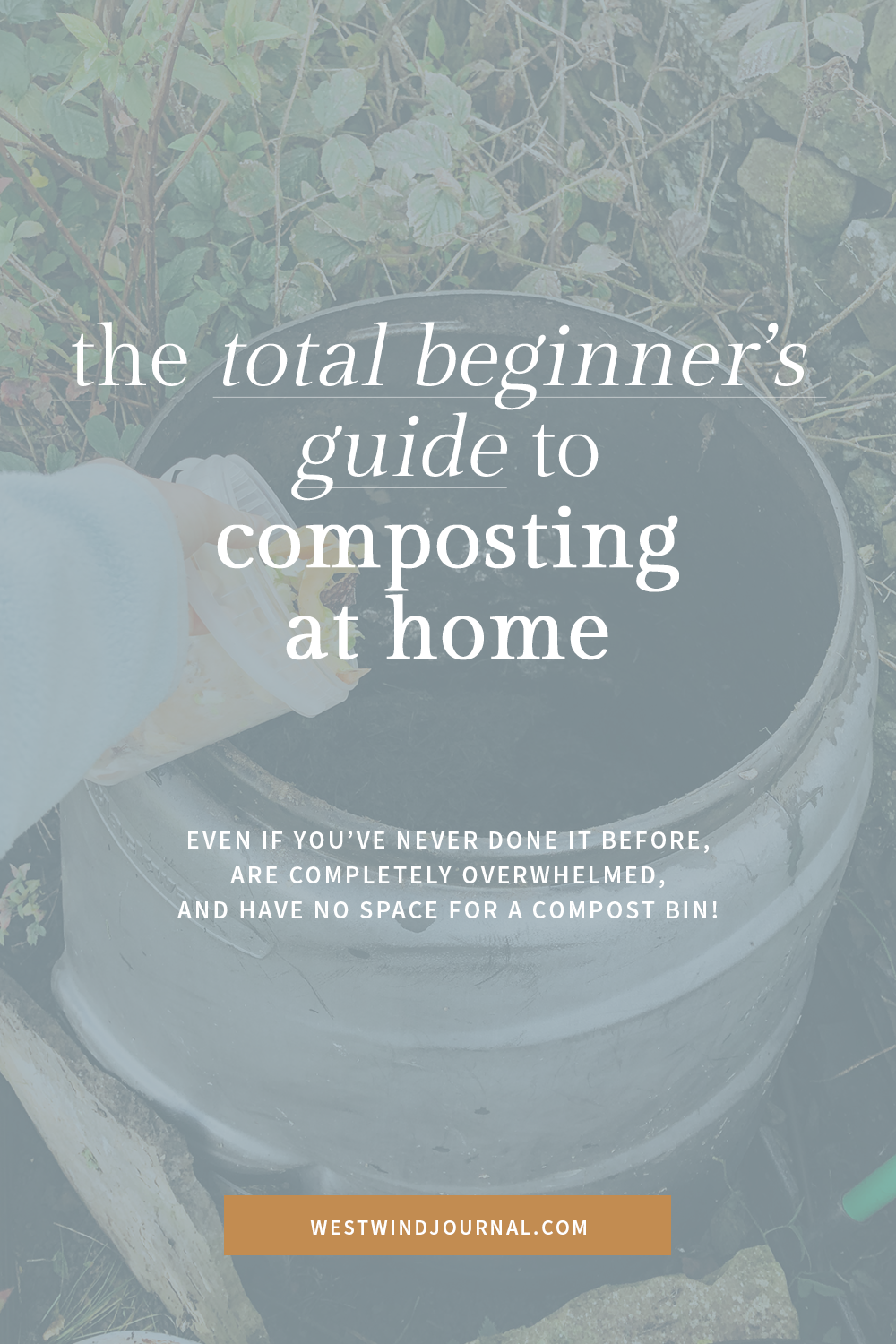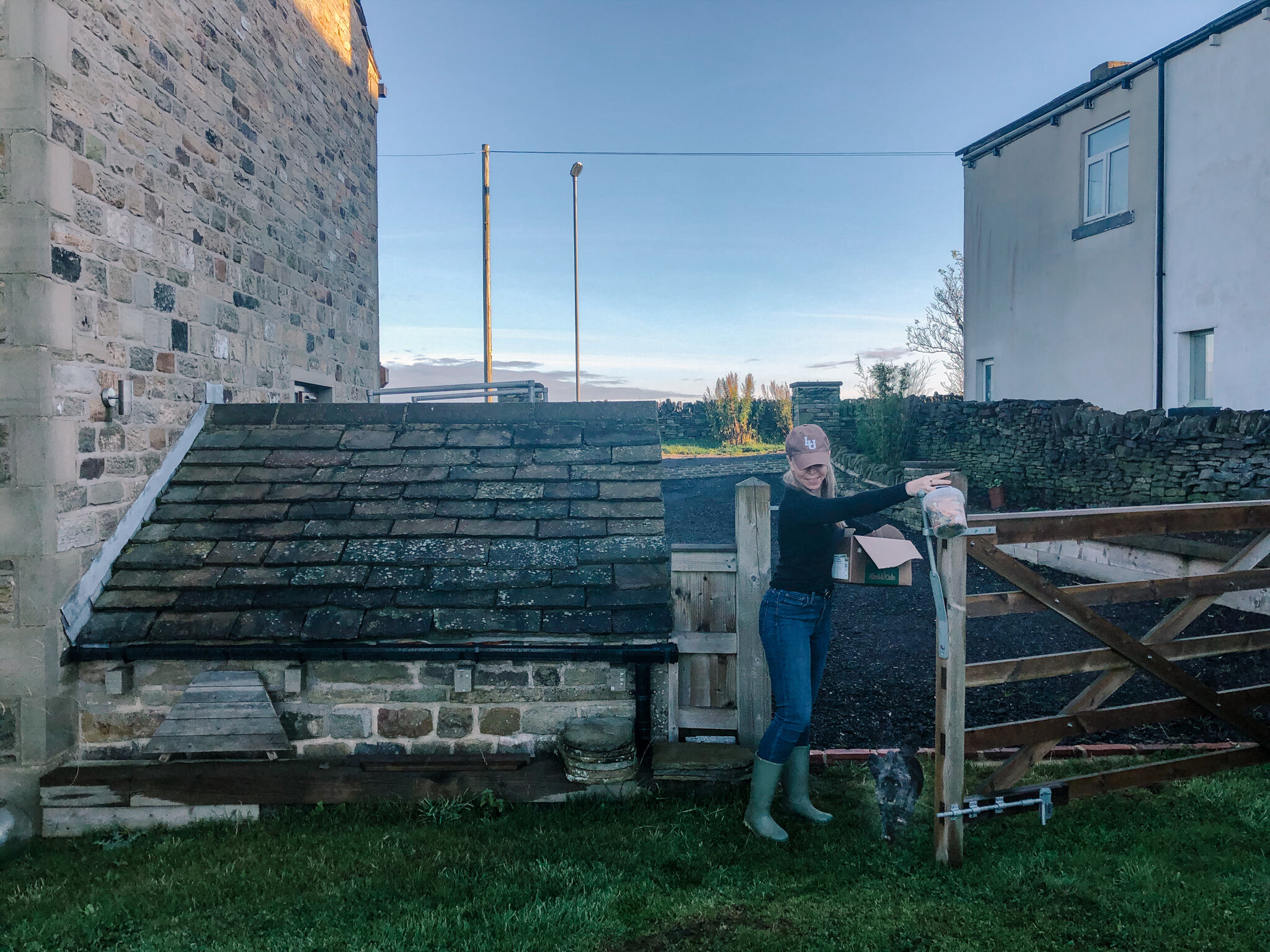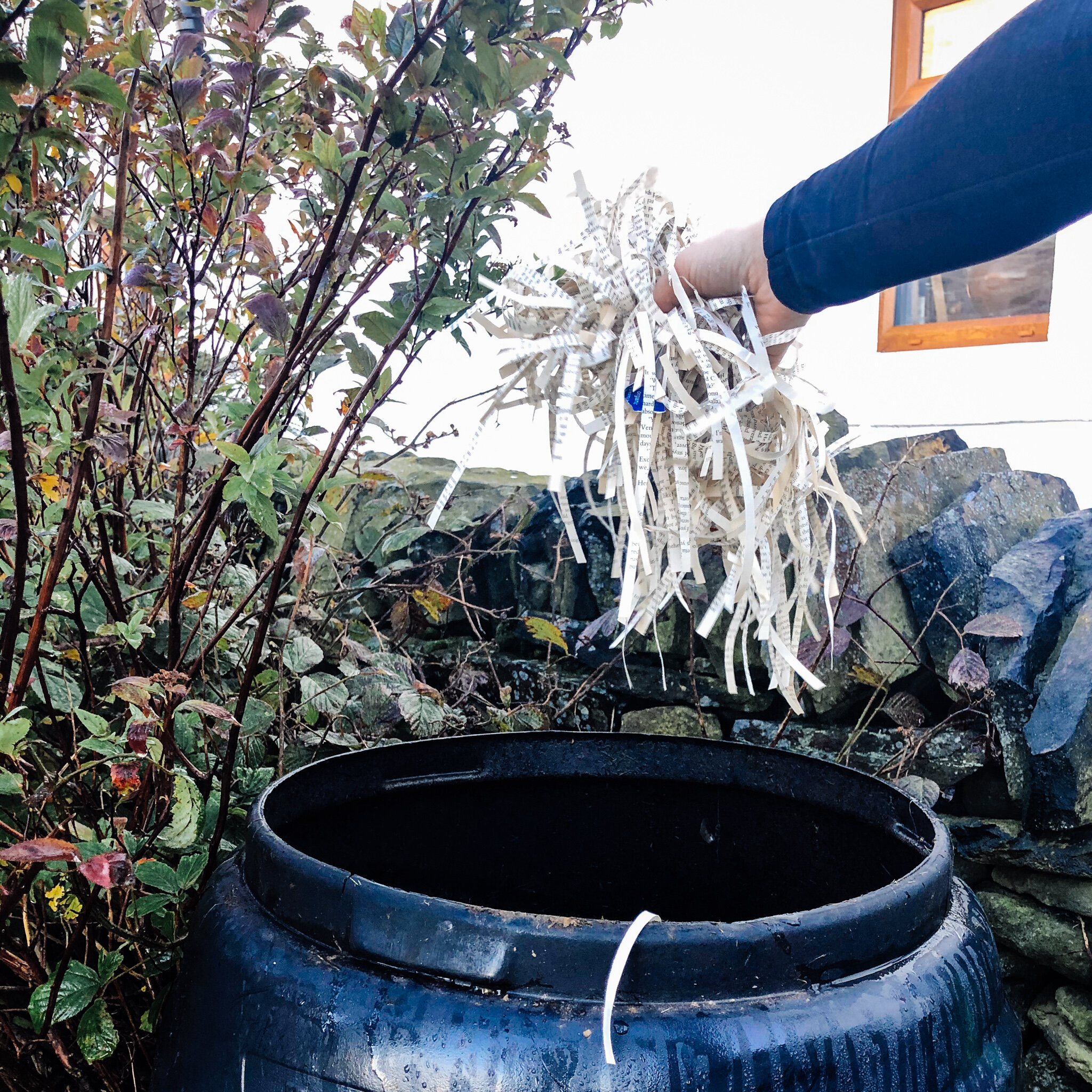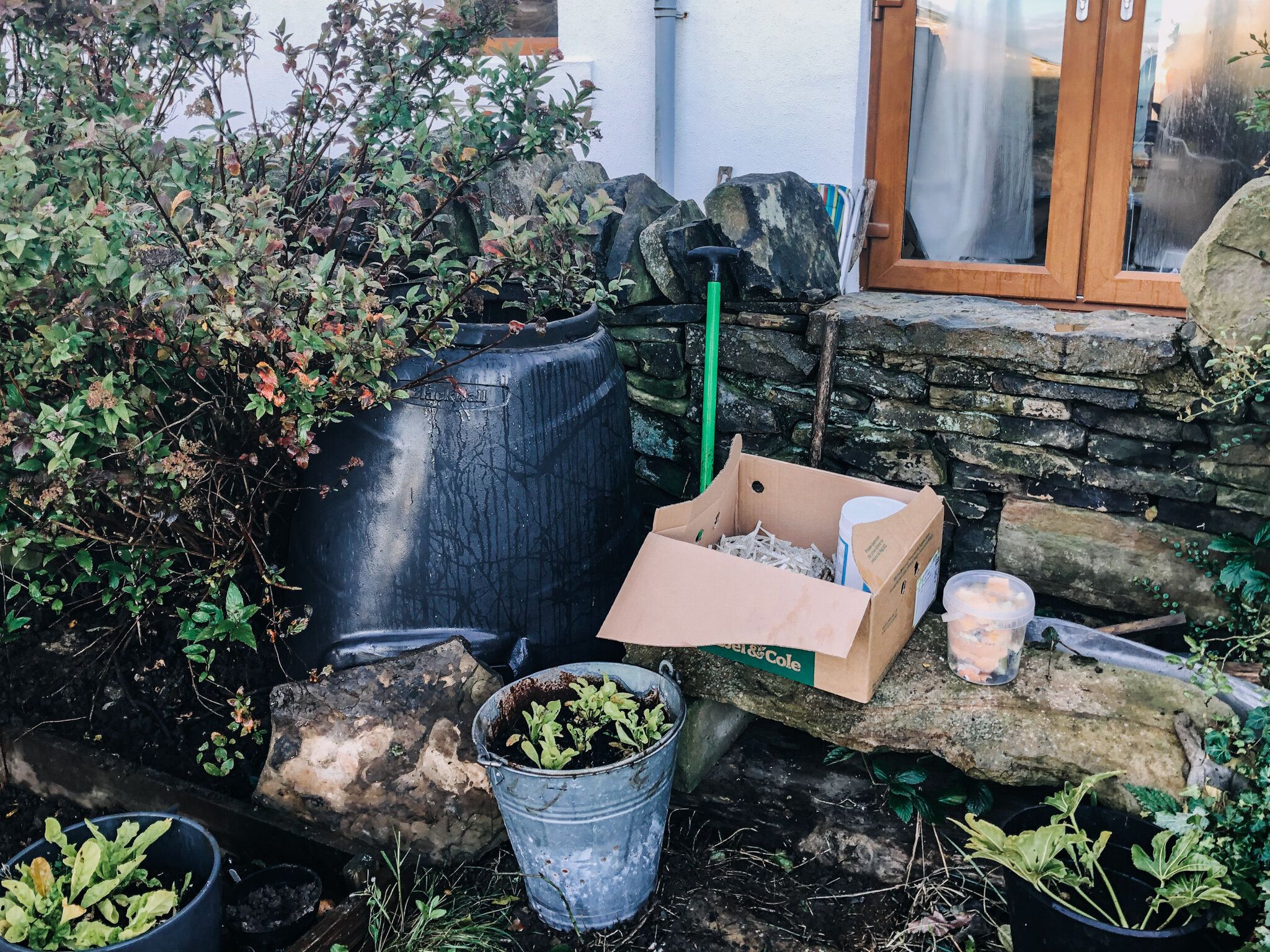How to compost at home for $0 [the total beginner’s guide]
What if there were a simple way to slash your household waste by a Hagrid-sized, whopping 60% this year?
...without reducing your consumption (so you don’t have to switch to toothpaste tablets)?
...AND while feeling more in tune with nature and the world around us?
When you know how to compost at home, that’s exactly what happens.
(And before you click away thinking this is hippie nonsense, just hear me out. I promise it’s way more doable than you think, no matter your situation.)
According to the book Compost by Rachelle Strauss, around 60% of household waste is compostable, meaning it will naturally break down if you give it the right conditions.
If you’re anything like me, there may be a few reasons why you think composting isn’t right for you:
a) You don’t have the space.
b) You don’t have the time.
c) It seems complicated and you don’t want to learn a million and one rules.
I used to think all that, too...but I was totally wrong. I created this blog post to help demystify how to compost at home because it’s surprisingly simple.
There are ways anyone can get involved, even if you don’t have space for a compost bin. And you can get started for precisely $0.
Every small step towards less waste is a good thing. Isn’t it worth learning a bit about how to compost at home to see if it’s right for you?
Promise I’ll give you everything you need to know (and nothing that you don’t). 😉
First off, what is composting, exactly?
Nature follows this beautiful cycle of birth-life-death-rebirth. Falling leaves don’t stay on the ground forever, right? They shrink, decompose, and return to the Earth, adding nutrients to the soil that help new life grow. It’s the natural way.
Buuuuut humans aren’t the best at following nature’s patterns…
When we send waste to a landfill, it doesn’t get the air and water it needs to break down properly (aerobically, in this case). So it decomposes anaerobically instead, taking up excess space and producing the harmful greenhouse gas methane. (According to the EPA, landfill waste is the third-largest source of human-related methane emissions, which is a big deal!)
What if, instead of going to landfill, that waste could decompose naturally, like leaves on the forest floor? Well, that’s what composting is!
Composting is basically the process of allowing organic materials to break down naturally, by giving them the right conditions. (Hint: NOT piling a bunch of other trash on top of it in a landfill. 😂)
And bonus: when organic materials decompose, they become plant superfood — thanks to microorganisms like bacteria and fungi plus bigger critters like worms that break them down. Finished compost is THE best fertilizer money can buy and it adds essential nutrients to the soil and also helps with water retention — all amazing things for the Earth.
People pay hundreds of pounds for compost…and you can get it for free while reducing your waste. It’s the ultimate win-win.
The simplest way to harness this magic is by learning how to compost at home, so you can allow (certain parts of) your household waste to naturally break down over time.
Let’s talk about how it works...
What can (and can’t) I add to my compost pile?
When you compost at home, you essentially throw a bunch of compostable materials into a pile and let it decompose over time. But not everything will naturally break down in your compost heap.
These items CAN be composted at home:
Fruit and veggie scraps — peels, cores, tops
Eggshells
Coffee grounds
Teabags (paper or natural materials only. If teabags are plastic, rip them open and add the tea leaves to compost.)
Plain paper — newspaper, brown packing paper, paper towels, bills, old books(nothing glossy); scrunched up or shredded
Cardboard; shredded
Wood ash from the fireplace
Garden waste — grass clippings, dead plants, leaves
Sawdust
Corks; chopped up
Feathers (from pillows or duvets)
Dead flowers and houseplants
Nutshells and pulp (from making nut milk)
Natural textiles — cotton, wool, and silk; chopped up
Compostable packaging — more companies are starting to do this, which is awesome! A few gems that I’ve found here in the UK are Abel & Cole, Planet Organic, and Percol coffee (which you can buy at Tesco, Sainsbury’s, or Waitrose.)
You can also compost some more…interesting things like human + pet hair, urine, nail clippings, and what’s in the vacuum cleaner. We’re not brave enough to add this stuff to ours but hey, if you’re more adventurous than us, go for it!
Here’s what cannot be composted at home:
Pretty much everything that’s NOT listed above, but especially…
Cooked foods
Meat
Bones
Dairy products
Keep these out of your compost bin. They’ll stunt the other ingredients’ decomposition and will attract vermin, which no one wants.
How to compost at home: the magic mix
After an in-depth consultation of the wide ol’ internet, the unanimous “most important thing” for good compost is a good mix of “browns” and “greens” in your pile.
These are just names to categorize compostable materials. Greens are high in nitrogen and tend to be wet. Browns are high in carbon and tend to be dry.
Example greens:
Fruit and veggie scraps
Grass cuttings
Green, leafy plants
Coffee grounds
Used teabags
Feathers that fall out of pillows or duvets
Example browns:
Paper, shredded or scrunched up
Cardboard, shredded
DRIED leaves
Sawdust
Wood ash
Cork
Nutshells
Woody branches, chopped small
Your compost pile needs a mix of both greens to browns to thrive.
The Royal Horticultural Society says to aim for between 25-50% greens in your mix.
Quick tip: For every 1 part of greens, add 2-4 parts browns to balance your compost pile.
It’s not an exact science so don’t get caught up in perfection as you test how to compost at home.
If your compost pile gets wet or smelly, add paper or dried leaves (browns). If it’s too dry, add more greens (or just water it). If you do those two things, you’re pretty much gonna get decent compost over time.
It’s really not rocket science and I promise, you can totally do this! 👍
What kind of container / space / time do I need?
COMPOST CONTAINERS
Most people use a container to store their compost pile outside. (If you don’t have space outside, keep reading, there are other great solutions for you!)
There are all sorts of compost containers and you can easily search for “compost bin” online if you’re looking to purchase one. Local councils often offer deals on compost bins so look there first. You can also search Freecycle groups near you to see if anyone has an old compost bin they’re getting rid of.
There are also plenty of ways to make a compost container for free, if you fancy getting creative. Click below for some tutorials I found for ya 😉:
You’ll also need a LIDDED container to store your food scraps inside between trips outside to fill the compost bin.
Again, you can buy one but it’s not necessary! We’ve been using old plastic tubs for about six months and they work just fine. 👌🏻 Our neighbors use an old dishwasher tablet tub.
I quickly rinse them after dumping out veggie scraps and I’ve never noticed any kind of smell. We’ve also never had any bugs or animals attracted by the scraps. Just make sure you’ve got a snug lid!
SPACE
All you need is a bit of indoor space to store your food scrap container — ours live under the kitchen sink — and a few square feet for your compost bin outside. That’s it!
If you don’t have any extra outdoor space (we don’t either) that’s okay. There are still solutions for how to compost at home, which we’ll get to in a minute.
TIME
Once a week-ish, you’ll empty your food scraps into the outdoor compost bin. And once a month-ish, you’ll turn the pile to make sure everything’s aerated.
Organic matter needs oxygen to fully decompose so we mix up our compost pile with a pitchfork every month-ish. But lots of people admit they never mix their compost and say it still comes out fine!
It also takes about an hour to set up your compost bin the very first time.
And that’s it!
2 containers
A bit of space
An hour to get started and a few minutes per week
That’s literally ALL you need to compost at home, reduce your household waste, and create amazing, nutritious compost to strengthen the health of your soil. 🙌🏻
I don’t have enough space for a compost bin. What can I do?
Not everyone has space for an outdoor compost bin. Like us — we only have a few square meters of land and didn’t fancy squeezing a compost bin onto our property.
But even if you don’t have space for your own personal compost bin, there are still plenty of ways you can get involved:
Community compost. Cardboard and paper are widely recycled. But did you know you can “recycle” compostable waste, too? Look into whether your town offers compost facilities. I have a friend in NYC who drops off food scraps in the community compost bin, which is only a short walk from her apartment. Some areas even offer garden and/or food waste collection services. Check your local council’s website to see what options are available to you.
Farmers markets. Our local farmers market collects compost materials. If it’s a while between markets, you can freeze your food scraps to prevent any grossness. You can also ask local farmers if they collect compost for their farms directly...or to point you in the right direction.
Sub-pod: I’m not one for buying products unnecessarily but this is a pretty ingenious option I just discovered! This compost bin sits under the soil, to save on space AND allow worms to easily filter through. Bonus: you can use it as a bench for seating. (See SubPod UK.)
Use a neighbor’s or friend’s compost bin. This is what we do! Our neighbors generously set up two compost bins and a few of us all use them together. (They also built some shared garden beds on their land so the compost goes to community use, too! And yes, I’m well aware I won the neighbor jackpot. 🤗) Alternatively, you could save up compostable stuff (freezing food scraps) and periodically drop them off at a friend’s compost bin.
Use public land. You could also *potentially* build a compost bin alongside a public footpath or in a field. Of course, you’d need to get permission from the person who owns the land first! But the worst they could do is say no, right? Before our neighbors offered shared composting, I was planning to ask a nearby restaurant if I could build a compost bin on their land that they could add their food scraps to. (This would be a great opportunity to get free local press, too!) I think a lot of people would be open to sharing their unused land if it benefits the community and the planet...but they need someone to give them that nudge. It truly never hurts to ask!
I’m sure there are other ways, too; these are just my initial ideas. Point being: just because you don’t personally have space, don’t think composting is out of the question for you. There are still loads of ways you can get involved and keep a huge chunk of your waste out of the landfill.
How do I get started composting at home?
If you’re feeling inspired as you’re reading this, that’s awesome! That means there’s something here you can use. The important thing is to keep that momentum going...
Come to it with a solution mindset. Rather than asking why composting wouldn’t work for you, think about how it could work for you — that approach has always helped me find creative solutions and workarounds.
If you’re ready to start to compost at home, here’s the system we used to set up our compost bin...
We conveniently re-started one of our neighborhood bins this week so it’s fresh in my mind! We followed the advice inside the book Compost by Rachelle Strauss to get started. Each layer was about 6-12 cm (3-5 in) deep:
Layer 1: twigs, for good drainage
Layer 2: garden soil or finished compost, to introduce microorganisms (with worms, if possible!)
Layer 3: food scraps, to attract worms and bacteria
Layer 4: moistened shredded cardboard
Layer 5: grass clippings
Layer 6: another layer of browns
After that, we’ll just continue adding greens and browns on top — as always, aiming for 2-4 parts browns to 1 part greens.
The main thing I hope you take away is that composting is easy, it’s far from an exact science, and it’s not a big deal if it doesn’t go perfectly. This is a journey and you can learn as you go — we certainly are!
It sounds lame but every time I walk to the compost bin with a bucket of veggie scraps, I get a little jolt of accomplishment. It feels so good to know I’m putting in a bit of effort to care for something other than myself.
Composting is a simple way you can make a real difference in the world...and these days, I’m holding tight to little ways I can “be the change” and all that.
I really hope this inspires you to give composting a go! The possibility of reducing your waste by 60% is so massive, it’s really worth the effort. Hagrid would definitely approve. ✨














